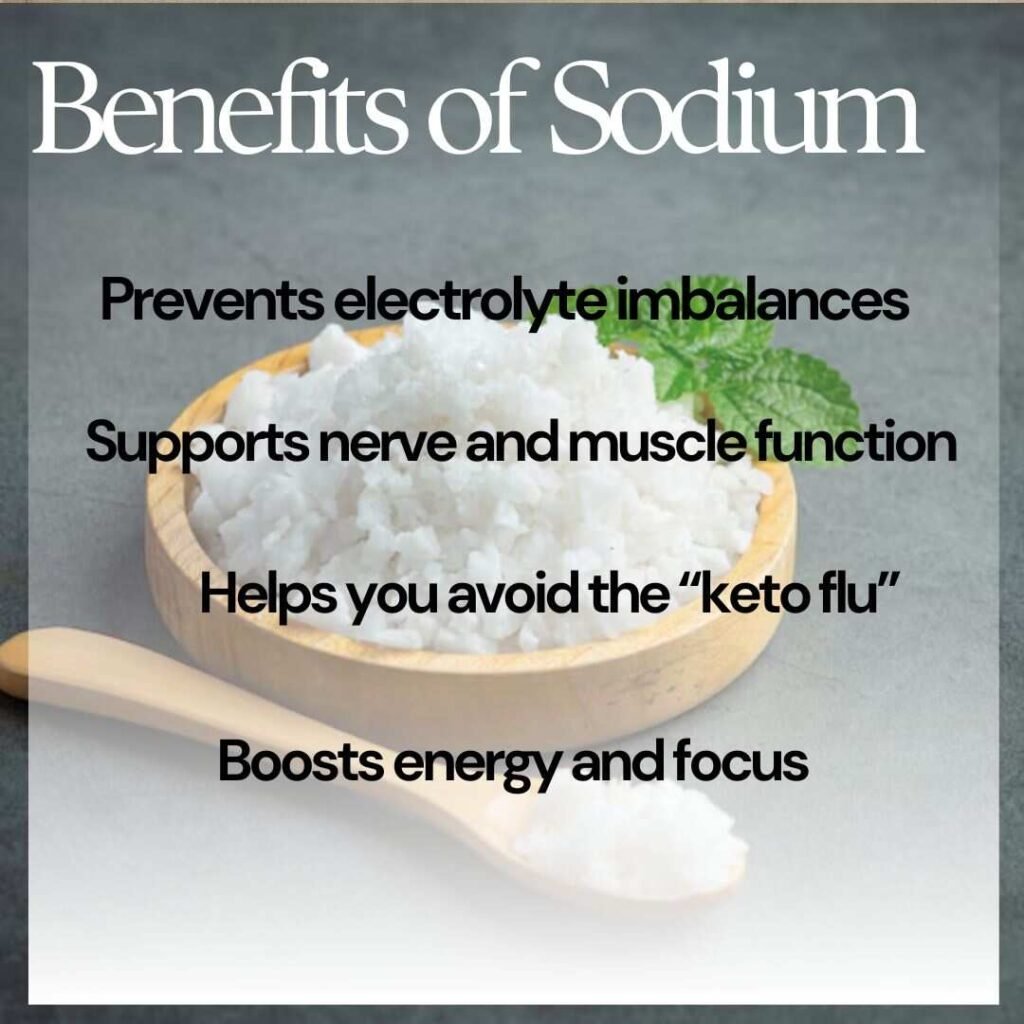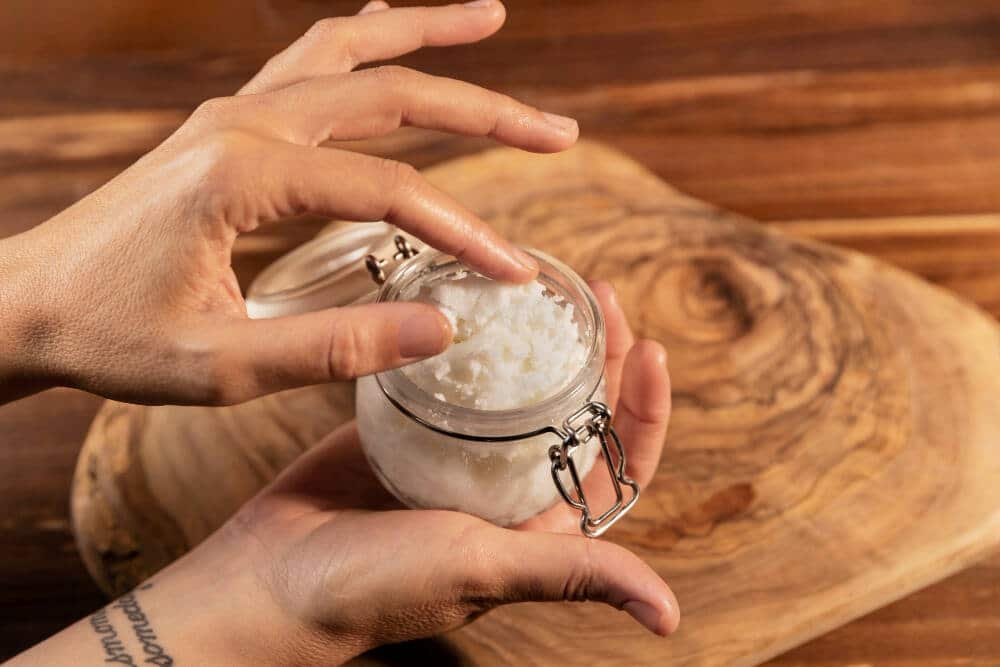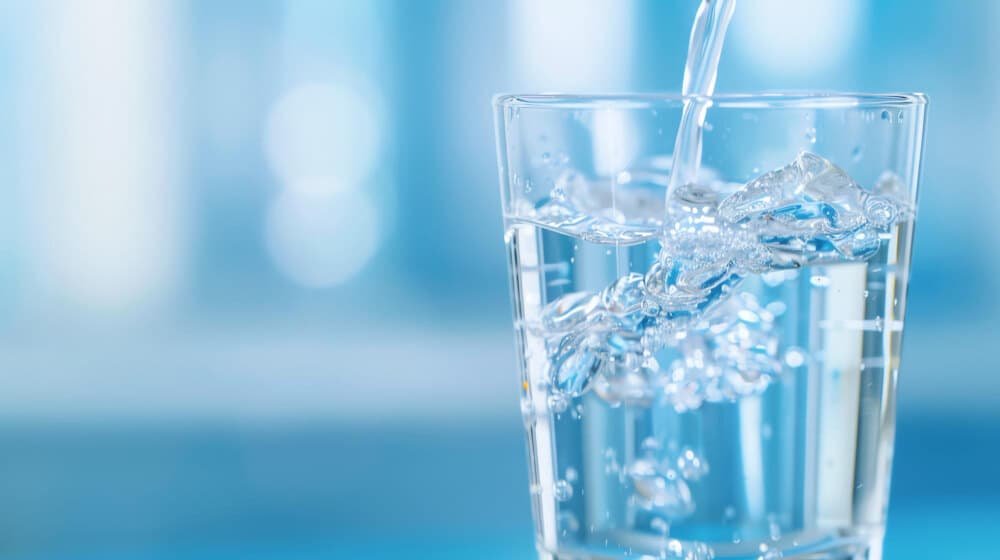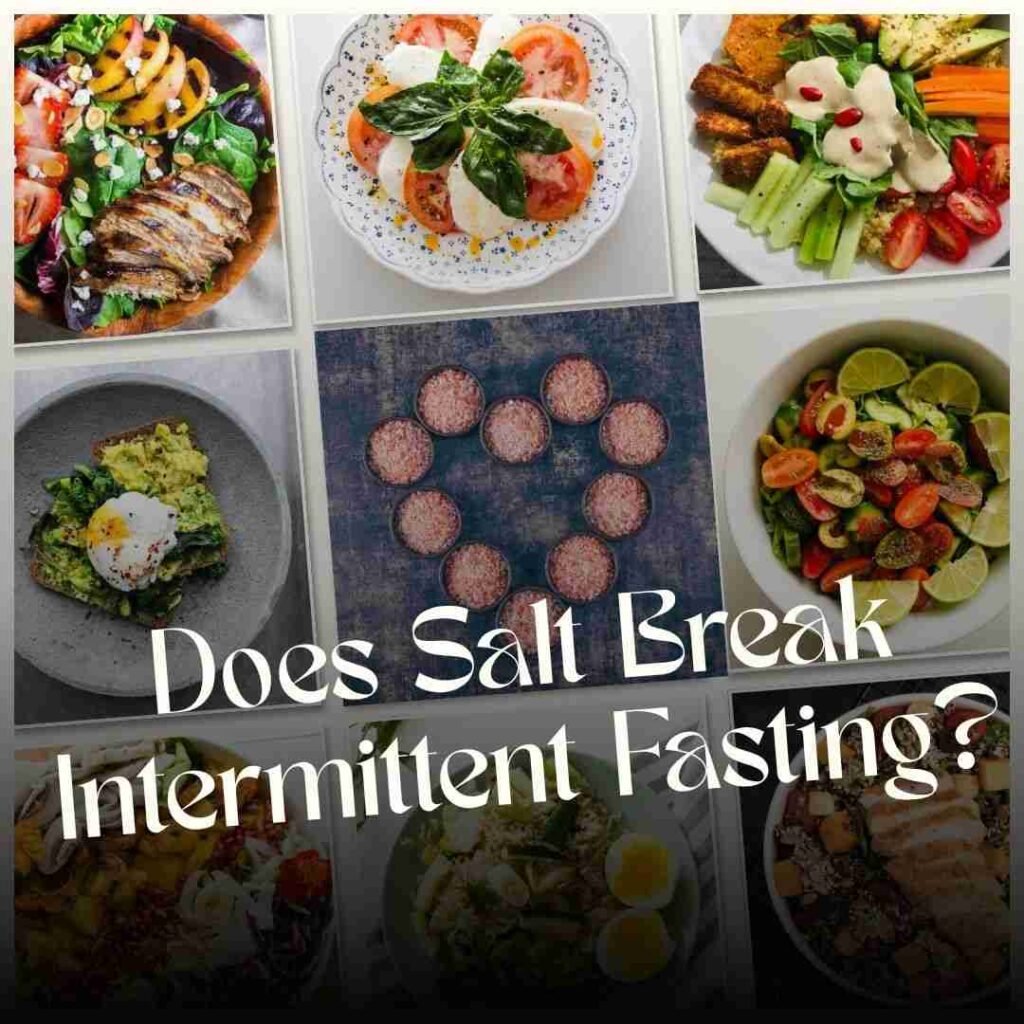A sprinkle of salt
Salt may be the essential seasoning for meals, but when it comes to fasting, the question often arises: Does salt break a fast? Most foods and drinks are off-limits during a fast, but what about trace minerals like sodium chloride?
The good news is that taking salt doesn’t break a fast.
“Your fasting method may clear your plate, but it shouldn’t clear your minerals. Salt is the backbone of your body’s balance.”
Replenishing electrolytes like sodium, magnesium, and potassium during your fasting period can make all the difference in how you feel and function. These minerals don’t contain calories and won’t raise insulin levels, meaning you stay in the fasting state while actually supporting your body’s needs.

Let’s explore why salt plays a bigger role in fasting than most people realize, and how it supports electrolyte balance, energy levels, and your overall health.
Does salt break intermittent fasting?
No, consuming salt doesn’t break a fast and can help maintain fluid balance and muscle function. So, your fasting state stays intact. What’s more, it’s actually something your body needs, especially during a fast.
When you’re drinking lots of water while fasting and not eating, your body tends to flush out essential minerals like sodium. This can leave you feeling lightheaded, crampy, or just plain tired.

“Salt doesn’t break your fast, it builds your resilience. It’s a quiet supporter of any weight loss journey.”
So, it’s often a good idea to include about 1.5 to 2 teaspoons of salt a day, particularly if you’re water fasting or sweating more than usual. Natural, unrefined salts like sea salt or Himalayan pink salt are packed with trace minerals and are a smarter option than regular table salt. They help keep your sodium levels in check and your energy steady throughout your fasting window.
What Actually Breaks a Fast?
A fast is broken when you consume anything that raises insulin or blood sugar levels significantly, like sugars, carbs, or even too much protein. But what about salt? It’s just sodium chloride, a mineral. It won’t impact your insulin response, and it contains zero calories. Your fasted state stays fully intact.
That means it won’t break your fast. It might be the best thing you can add to your routine during your fasting window.
“Calories spike insulin. Salt doesn’t. That’s the difference between breaking your fast and mastering your fasting method.”
The Role of Salt in the Fasting State
Salt, also known as sodium chloride, is more than just a seasoning. It’s an essential nutrient required for muscle function, nerve impulses, and maintaining fluid balance. During intermittent fasting, your insulin levels drop, leading to increased sodium excretion and fluid loss.
This is why many people experience symptoms like muscle cramps, dizziness, low energy levels, and fatigue while fasting. These symptoms are often caused by an electrolyte imbalance, not the fasting itself.
“Sodium keeps your digestive system and muscles communicating — without it, your fasted body falls out of sync.”
Replacing key electrolytes, especially sodium, helps maintain energy levels, support physical activity, and prevent muscle weakness.
Benefits of Sodium While Fasting
Sodium plays a much bigger role in fasting than most people realize. During a fast, your insulin levels drop. While this is great for fat burning, it also signals your kidneys to flush out more sodium through urine. That’s why you may notice symptoms like fatigue, lightheadedness, muscle cramps, or even brain fog, especially if you’re drinking a lot of plain water without replenishing your minerals.

Getting enough sodium while fasting helps in several key ways:
1. Prevents electrolyte imbalances
Sodium is a core electrolyte that helps balance fluids in and around your cells. When you fast, you’re not getting any sodium from food. Without replenishment, this imbalance can lead to symptoms that are often mistaken for hunger, dehydration, or weakness.
2. Supports nerve and muscle function
Your muscles and nerves rely on sodium to send signals. Low sodium levels can cause cramps, irregular heartbeats, and that shaky, drained feeling many people get during the early stages of a fast. Maintaining sodium intake keeps your muscles relaxed and your nervous system stable.
3. Helps you avoid the “keto flu”
When you enter ketosis, your body loses even more sodium through increased urination. This is part of what causes the infamous “keto flu”, that sluggish, achy state some people feel when switching to low-carb eating. Adequate sodium helps prevent or reduce those symptoms.
4. Boosts energy and focus
Without proper sodium, your body has to work harder to maintain balance, which can make you feel tired or mentally foggy. Proper sodium intake during fasting supports steady energy levels and better mental clarity.
“A fast without sodium is like driving cross-country with no gas. Your body needs electrolytes to go the distance.”
Why You Lose Salt While Fasting
During fasting, lower insulin levels signal your kidneys to flush out sodium. Add to that any physical activity, and you’re at risk for losing too much sodium and other essential minerals like potassium and magnesium.
This loss of essential electrolytes can lead to:
- Muscle cramps
- Headaches
- Weakness
- Heart palpitations
- Symptoms that mimic serious health issues like kidney disease or heart disease
“During any fast, your body flushes out salt. If not replaced, it can tip you into negative sodium balance and exhaustion.”
The Best Types of Salt for Fasting
Not all salt is created equal. Here’s a quick breakdown:
| Type of Salt | Mineral Content | Benefits |
|---|---|---|
| Regular Table Salt | Highly refined | Provides sodium but lacks trace minerals |
| Pink Himalayan Salt | Rich in trace minerals | Helps with muscle contraction and electrolyte balance |
| Celtic Sea Salt | Contains magnesium, calcium | Supports energy levels and reduces muscle cramps |
| Baja Gold Sea Salt | Very high in mineral content | Excellent for deep electrolyte replenishment |
Using a mineral-rich salt during your fasting window supports electrolyte levels and helps you stay in a fasted state longer and more comfortably.
“Mineral-rich salts don’t just season, they strengthen. Especially during fasts, they’re key for hydration and nerve stability.”
How Much Sodium Do You Need?
A good rule of thumb during intermittent fasting is to consume about 1–2 grams of mineral-rich salt per day. This can be done by adding it to water (known as salt water), mineral water, or even black coffee. But some important consideration helps most people maintain balance.
For most people, 1.5 to 2 teaspoons of mineral-rich salt per day is ideal.
This translates to around 4 to 5 grams of salt, or approximately 1.5 to 2 grams of sodium. This small amount, spaced throughout the day, can dramatically improve how you feel during a fast.

If you’re active or sweat a lot, you may need slightly more. Physical activity increases sodium loss, so it’s important to pay attention to how your body feels and adjust as needed.
“Finding your optimal intake isn’t about guesswork; it’s an important part of personalizing your fasting method for better results.”
During extended fasts
The need for sodium increases significantly during longer fasts, especially in the first few days. That’s when your body is rapidly shedding water and electrolytes. Without adequate sodium, you’re more likely to experience symptoms like low blood pressure, dizziness, or muscle twitching.
“As your fast stretches longer, your sodium needs increase. The key to endurance lies in small but steady mineral support.”
Important considerations If you have high blood pressure, kidney disease, or are taking diuretics or certain medications, speak with your healthcare provider before increasing sodium intake. Otherwise, for most healthy individuals, the right amount of high-quality salt can make fasting safer and far more sustainable. Having too much salt is not advisable; always listen to your body.
“If you’re managing health conditions, sodium isn’t something to fear, but it is something to monitor wisely.”
Sources of sodium while fasting
Sodium can be replenished in a few simple, fasting-safe ways. The key is to avoid processed table salt and instead opt for natural sources that support your body’s mineral needs.
1. Mineral-rich salts – Himalayan pink salt, Celtic Sea salt, and Baja Gold Sea salt are excellent choices. These contain not just sodium but also trace minerals like magnesium and calcium. Adding a pinch to your water or black coffee during a fast is a gentle, effective way to stay balanced.
2. Natural mineral water – If you’re fasting and drinking only purified or distilled water, you may be flushing out essential electrolytes without replacing them. Mineral water provides a natural source of sodium and other trace minerals without adding calories or artificial ingredients.

3. Electrolyte supplements (no sugar or fillers) – Clean electrolyte powders or capsules are a convenient option. Just make sure they’re free from sweeteners, dyes, or additives that can break your fast or trigger an insulin response. Look for products with a good sodium-to-potassium ratio and minimal ingredients.
“Natural sources of salt and electrolytes support your fasting window without calories, and without compromising your digestive system.”
These options not only support your fasting goals but also help you avoid common issues like headaches, muscle cramps, and fatigue.
Salt, Ketosis, and the Ketogenic Diet
If you’re following a ketogenic diet or using alternate-day fasting, salt is even more important. Ketosis leads to a greater loss of sodium through urine, which means you need more salt to maintain balance.

Getting enough sodium helps:
- Sustain energy during the fasting window
- Avoid muscle function issues
- Support fat burning
- Reduce insulin resistance
- Improve insulin sensitivity
“Sodium needs can also change significantly if you’re following a low-carb or ketogenic lifestyle.”
Symptoms of Low Sodium During Fasting You Shouldn’t Ignore
If you’re drinking plenty of non-caloric beverages like plain water, black coffee, or herbal tea during your fast, that’s great for hydration, but it can also lead to faster sodium loss. When your electrolyte levels drop, your body begins to send out warning signs, and they’re often mistaken for hunger or fatigue.

Here are some symptoms of low sodium you may notice:
- Feeling weak or shaky, especially first thing in the morning
- Dizziness or brain fog during your eating window
- Nausea or digestive discomfort
- Muscle cramps, especially during physical activity
- Trouble focusing, low mood, or irritability
Many people start fasting to burn body fat and gain various health benefits but overlook how critical adequate salt intake is to that success. Without enough sodium, your body struggles to maintain balance, no matter how perfect your fasting plan or amount of calories consumed during meals.
If you’re hitting a wall during your fast, it might not be about willpower. Your body could simply be asking for more salt.
When to Be Cautious with Salt During Intermittent Fasting
While salt is a key energy source for your cells during fasting, it’s not a free-for-all. Adding sodium to your routine can improve hydration, reduce fatigue, and even help you extend your eating window comfortably, but only when used wisely.
If you have medical conditions like high blood pressure, heart disease, or kidney issues, increasing salt intake without guidance can do more harm than good. The same goes if you’re taking medications like diuretics, which can already affect fluid and mineral balance.
As your insulin levels drop, your kidneys excrete more sodium, leading to potential imbalances … it can lead to fatigue, dizziness, muscle cramps, and other undesirable side effects that may hinder your fasting experience.”— Fasting Lane, “The Vital Role of Salt in Intermittent Fasting”
Even during a fast, when you’re not consuming your usual amount of calories, salt still affects your body’s fluid balance. That makes it an important consideration if you’re fasting for religious reasons, practicing alternate-day fasting, or following a low-carb diet.
In short? Use salt as a tool, not a shortcut. Talk to your doctor if you’re unsure how much is right for your personal needs.
Common Mistakes People Make with Salt While Fasting
Using salt during intermittent fasting can be a great way to maintain good health, support hydration, and enhance energy, but many people unknowingly sabotage their results with a few avoidable mistakes.
Here are the most common mistakes to watch out for:
1. Only using regular table salt
Table salt is often stripped of minerals and pumped with additives. It lacks the trace elements that support electrolyte balance, nerve function, and hydration. Opt for mineral-rich salts like Himalayan pink salt or Celtic sea salt for better results.
2. Not drinking enough water with your salt
Salt needs to be paired with adequate water intake to work effectively. Too little water and you risk dehydration; too much without salt and you flush out critical electrolytes. Find your sweet spot, especially if you’re consuming non-caloric beverages throughout your fast.
“When you stop feeding your body … ketones are anions … they like to take cations (positively charged molecules). Guess which two cations are their favorites? Sodium and potassium.”
— Dave Asprey, “Why You Should Never Fast Without Electrolytes”
3. Overusing salt without understanding your needs
Dumping salt into every drink isn’t the answer. Your optimal milligrams of salt per day depends on your activity level, climate, and how long your fast lasts. Always consider your requirements and any medical conditions before increasing sodium.
4. Assuming all salt is the same
Not all salts are created equal. Some contain zero trace minerals while others offer a spectrum of nutrients. Choosing high-quality salt is an important consideration if you’re fasting for various health benefits like fat loss, mental clarity, or digestive support.
5. Thinking salt breaks your fast
This is a common question, but it’s a myth. Salt is non-caloric, does not spike insulin, and won’t disrupt your eating window or fasted state. Instead, it can improve your energy, stabilize your mood, and protect your glycogen stores.
Avoiding these simple mistakes can elevate your fasting experience, helping you stay more energized, focused, and balanced, without compromising your goals or well-being.
The Best Intermittent Fasting Guide Just for Women
If you’ve tried every diet and wellness trend out there but still can’t shake that stubborn body fat, you’re not alone, and it’s not your fault.
Intermittent Fasting for Women is different. This book isn’t about pushing yourself harder; it’s about understanding your unique body and working with it, not against it.
Written just for women, this guide offers science-backed fasting plans that fit your busy life, simple meal ideas that nourish without stress, and real solutions for the challenges you face on your journey.
Whether you’re brand new to fasting or want to finally make it work for you, this book is your roadmap to more energy, better health, and the confidence you deserve.
Ready to feel great in your skin? Grab your copy on Kindle today and start your journey on your terms.
Can I drink salt water during fasting?
Yes. As long as it contains no calories, salt water with mineral-rich salt supports electrolyte balance and helps prevent muscle cramps.
Does pink Himalayan salt break a fast?
No. Pink Himalayan salt is rich in essential minerals and does not trigger an insulin response or affect your calorie intake.
What if I feel weak or dizzy during fasting?
This is often due to low sodium or electrolyte imbalance. A pinch of salt can restore balance and help you feel better.
Should I choose salt or an electrolyte supplement?
This depends on individual needs. Many prefer natural salts like Celtic sea salt or Baja Gold sea salt. Others choose clean electrolyte mixes. Just ensure they’re free from additives.
What are the signs of not getting enough salt?
Muscle weakness, cramps, headaches, and digestive issues are symptoms of low sodium. These can make fasting feel harder than it needs to be.
Can salt help with fat loss?
Yes, especially if you’re on a ketogenic diet. Salt supports energy production, maintains electrolyte levels, and helps sustain the fasting state necessary for fat burning.
Salt & Fasting – A Great Way to Support Good Health
A common question in fasting is whether salt breaks your fast; the answer is no. In fact, adequate salt intake during your fasting window helps balance electrolytes, supports good health, and boosts energy without adding calories. Especially if you’re drinking excess water or fasting for religious reasons, replenishing milligrams of salt is key.
It’s a great way to avoid fatigue, protect glycogen stores, and burn body fat efficiently. Just be mindful of medical conditions and always pair fasting with a healthy diet during your periods of eating for the best results.
The best thing you can do is find the right type of salt and listen to your body. Stay hydrated, support your body’s essential needs, and use salt as a helpful tool, not something to avoid.



